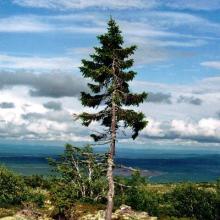Picea abies
Common name:
Norway spruce
Genus:
Picea
Family:
Pinaceae
Order:
Pinales
Picea abies
Common name:
Norway spruce
Genus:
Picea
Family:
Pinaceae
Order:
Pinales
Picea abies
Common name:
Norway spruce
Genus:
Picea
Family:
Pinaceae
Order:
Pinales
Genus (Plantae): Picea
A spruce is a tree of the genus Picea (/paɪˈsiː.ə/ py-SEE-ə), a genus of about 40 species of coniferous evergreen trees in the family Pinaceae, found in the northern temperate and boreal (taiga) regions of the Earth. Picea is the sole genus in the subfamily Piceoideae. Spruces are large trees, from about 20 to 60 m (about 60–200 ft) tall when mature, and have whorled branches and conical form.
They can be distinguished from other members of the pine family by their needles (leaves), which are four-sided and attached singly to small persistent peg-like structures (pulvini or sterigmata) on the branches, and by their cones (without any protruding bracts), which hang downwards after they are pollinated. The needles are shed when 4–10 years old, leaving the branches rough with the retained pegs. In other similar genera, the branches are fairly smooth.
Spruce are used as food plants by the larvae of some Lepidoptera (moth and butterfly) species, such as the eastern spruce budworm. They are also used by the larvae of gall adelgids (Adelges species).
In the mountains of western Sweden, scientists have found a Norway spruce, nicknamed Old Tjikko, which by reproducing through layering, has reached an age of 9,550 years and is claimed to be the world's oldest known living tree.
Description
Morphology
Determining that a tree is a spruce is not difficult; evergreen needles that are more or less quadrangled, and especially the pulvinus, give it away. Beyond that, determination can become more difficult. Intensive sampling in the Smithers/Hazelton/Houston area of British Columbia showed Douglas (1975), according to Coates et al. (1994), that cone scale morphology was the feature most useful in differentiating species of spruce; the length, width, length: width ratio, the length of free scale (the distance from the imprint of the seed wing to the tip of the scale), and the percentage free scale (length of free scale as a percentage of the total length of the scale) were most useful in this regard. Daubenmire (1974), after range-wide sampling, had already recognized the importance of the 2 latter characters. Taylor (1959) had noted that the most obvious morphological difference between typical Picea glauca and typical P. engelmannii was the cone scale, and Horton (1956,1959) found that the most useful diagnostic features of the 2 spruces are in the cone; differences occur in the flower, shoot and needle, "but those in the cone are most easily assessed" (Horton 1959). Coupé et al. (1982) recommended that cone scale characters be based on samples taken from the midsection of each of 10 cones from each of 5 trees in the population of interest.
Without cones, morphological differentiation among spruce species and their hybrids is more difficult. Species classification for seeds collected from spruce stands in which introgressive hybridization between white and Sitka spruces (P. sitchensis) may have occurred is important for determining appropriate cultural regimens in the nursery. If, for instance, white spruce grown at container nurseries in southwestern British Columbia are not given an extended photoperiod, leader growth ceases early in the first growing season, and seedlings do not reach the minimum height specifications. But, if an extended photoperiod is provided for Sitka spruce, seedlings become unacceptably tall by the end of the first growing season. Species classification of seedlots collected in areas where hybridization of white and Sitka spruces has been reported has depended on (i) easily measured cone scale characters of seed trees, especially free scale length, (ii) visual judgements of morphological characters, e.g., growth rhythm, shoot and root weight, and needle serration, or (iii) some combination of (i) and (ii) (Yeh and Arnott 1986). Useful to a degree, these classification procedures have important limitations; genetic composition of the seeds produced by a stand is determined by both the seed trees and the pollen parents, and species classification of hybrid seedlots and estimates of their level of introgression on the basis of seed-tree characteristics can be unreliable when hybrid seedlots vary in their introgressiveness in consequence of spatial and temporal variations in contributions from the pollen parent (Yeh and Arnott 1986). Secondly, morphological characters are markedly influenced by ontogenetic and environmental influences, so that to discern spruce hybrid seedlot composition with accuracy, hybrid seedlots must differ substantially in morphology from both parent species. Yeh and Arnott (1986) pointed out the difficulties of estimating accurately the degree of introgression between white and Sitka spruces; introgression may have occurred at low levels, and/or hybrid seed lots may vary in their degree of introgression in consequence of repeated backcrossing with parental species.
Reference: Wikipedia

